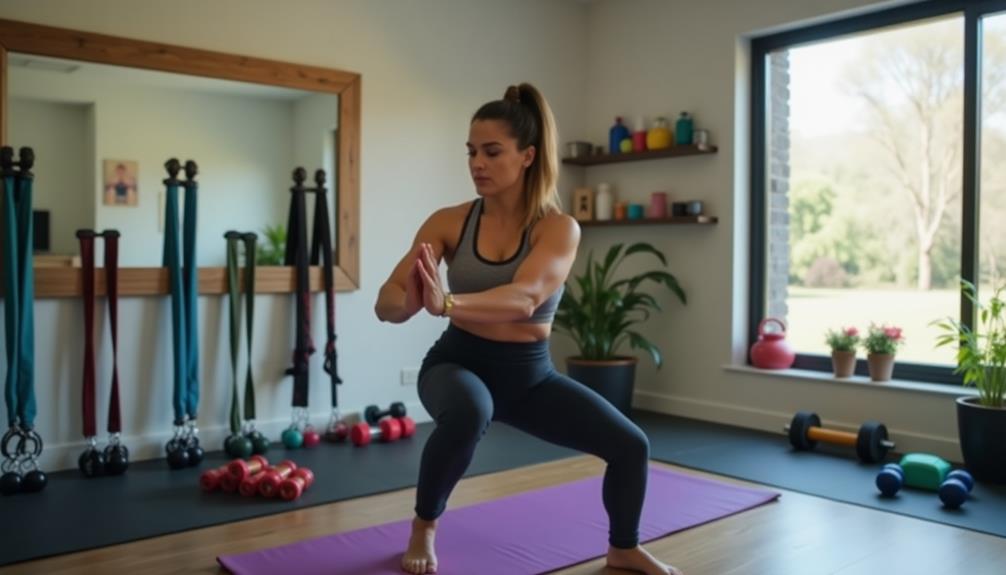To achieve muscle tone with resistance training, start by understanding your goals. Incorporate workouts at least three times a week, focusing on various muscle groups. Use free weights, machines, resistance bands, or bodyweight exercises. Aim for 2-4 sets of 8-12 reps to promote toning. Prioritize proper form—keep a neutral spine and engage your core to avoid injury. Track your progress to stay motivated and adjust your routine as needed. Remember, consistency is key for results. Also, consider your nutrition to support your muscle tone journey. There's much more to uncover that can enhance your approach.
Core Insights
- Set clear fitness goals for muscle toning, focusing on strength and endurance to guide your resistance training routine.
- Incorporate at least three sessions of resistance training per week to consistently enhance muscle tone over time.
- Utilize a variety of exercises targeting different muscle groups, including free weights, machines, bands, and bodyweight movements.
- Perform 2-4 sets of 8-12 repetitions for each exercise to effectively stimulate muscle toning.
- Maintain proper form and technique to maximize benefits and reduce the risk of injury during workouts.
Understanding Muscle Tone

Muscle tone refers to the slight tension in your muscles at rest, which gives them a firm appearance. It's crucial to understand that muscle tone isn't the same as muscle size or strength. Instead, it's about how your muscles maintain a degree of contraction, even when you're not actively using them. Resistance training plays a vital role in achieving and maintaining an ideal muscle tone, as it helps to build lean muscle mass and improve overall body composition.
Several factors influence muscle tone, including genetics, activity level, and overall fitness. Regular physical activity can enhance your muscle tone, making your muscles look more defined.
Moreover, muscle tone can vary between different muscle groups in your body. Focusing on exercises that target specific areas can help you reach your desired level of muscle tone. Remember, consistency is crucial to witnessing improvements in your muscle tone over time.
Benefits of Resistance Training

Furthermore, resistance training can improve your mental health by reducing anxiety and stress levels. It promotes better sleep patterns, leading to increased energy throughout the day. Privacy and security are important considerations when tracking your fitness progress online. As you build muscle, you'll also gain greater functional strength, making everyday tasks easier. Finally, committing to a resistance training routine fosters discipline and motivation, empowering you to set and achieve fitness goals.
Types of Resistance Exercises

When it comes to resistance exercises, you have a variety of options to choose from, each targeting different muscle groups and fitness goals. Free weights, like dumbbells and barbells, are great for building strength and muscle tone. Machines offer guided movements, which can be helpful for beginners. Resistance bands provide versatility and are excellent for home workouts. Resistance bands sets often come with multiple resistance levels, ranging from light to heavy, allowing you to progress as you get stronger. These bands are also highly portable, making them ideal for travel or quick workouts at home. Bodyweight exercises, such as push-ups and squats, use your own weight for resistance and can be done anywhere. Plyometric exercises incorporate explosive movements, enhancing power and agility. Finally, kettlebells combine strength and cardio, offering a dynamic workout. By mixing these types, you can create a balanced routine that keeps your muscles challenged and engaged.
Setting Up Your Routine

Developing an effective resistance training routine is crucial for achieving muscle tone and overall fitness. Start by determining your fitness goals. Do you aim to build strength, endurance, or both? Next, choose the frequency of your workouts. Strive for at least three sessions per week, allowing for recovery days in between.
Then, select a variety of exercises targeting different muscle groups. This guarantees balanced development and prevents overuse injuries. It's also important to decide on the number of sets and repetitions. Generally, 2-4 sets of 8-12 reps work effectively for muscle toning.
Lastly, track your progress. Record your weights, reps, and how you feel. Adjust your routine as necessary to continue challenging yourself and stay motivated!
Proper Form and Technique

Proper form and technique are essential for maximizing the benefits of resistance training while minimizing the risk of injury. When you perform exercises with proper form, you're not only targeting the intended muscles effectively but also protecting your joints and connective tissues.
Here's a quick reference table to help you remember key points:
| Exercise Component | Key Tips |
|---|---|
| Body Alignment | Keep your spine neutral and engage your core. |
| Joint Movement | Move through a full range of motion without locking joints. |
| Breathing | Exhale during exertion and inhale during the release. |
Tracking Your Progress

Maintaining proper form and technique lays a solid foundation for your resistance training journey, but tracking your progress is what truly helps you stay motivated and informed about your gains.
Why Track?
By keeping a record, you can see how far you've come and identify areas for improvement.
How to Track?
Use a workout journal or an app. Note the exercises, sets, reps, and weights used.
Set Goals
Establish short-term and long-term goals. This gives you something to aim for and keeps you focused.
Review Regularly
Look back at your entries every few weeks. Celebrate your achievements and adjust your routine as needed.
Tracking your progress is essential for continual improvement and helps maintain your enthusiasm for your training regimen.
Nutrition for Muscle Tone

Here's a quick guide to help you understand what to include in your meals:
| Nutrient | Examples |
|---|---|
| Protein | Chicken, fish, legumes |
| Healthy Fats | Avocado, nuts, olive oil |
| Complex Carbs | Quinoa, brown rice, sweet potatoes |
| Hydration | Water, herbal teas |
Proper nutrition not only fuels your workouts but also aids in recovery. Make sure you're eating enough to support your goals, and don't forget to stay hydrated!
Frequently Asked Questions
How Long Until I See Results From Resistance Training?
You'll typically notice some results within four to six weeks of consistent resistance training. Factors like your initial fitness level, workout intensity, and nutrition play an important role in how quickly you see changes.
Can Resistance Training Help With Weight Loss?
Think of resistance training as a sculptor chiseling away at a block of marble. Yes, it can help with weight loss by building muscle, boosting metabolism, and burning calories, leading to a leaner physique over time.
Is Resistance Training Safe for Seniors?
Yes, resistance training can be safe for seniors. It helps build strength, improve balance, and enhance overall health. Just make sure you start with lighter weights, focus on proper form, and consult a healthcare professional if needed.
What Equipment Do I Need to Start?
You don't need a gym full of fancy gear. Start with dumbbells, resistance bands, and a sturdy mat. These basics'll set you up perfectly for effective resistance training and help you tone up in no time!
How Often Should I Change My Workout Routine?
You should change your workout routine every 4 to 6 weeks. This keeps your body challenged, prevents plateaus, and helps you stay motivated. Don't forget to listen to your body and adjust as needed!

